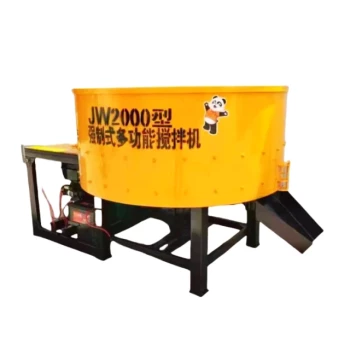The production capacity of a combined concrete mixing station is determined by a combination of equipment capabilities, operational efficiency, and external factors. Key influences include the mixer's theoretical and actual output rates, raw material quality/availability, logistics (like transport vehicle configuration), storage capacity, and market demand. The large concrete mixer is central to this system, but its performance is optimized or constrained by supporting infrastructure and supply chain variables.
Key Points Explained:
-
Equipment Specifications
- The core determinant is the rated capacity of the mixing unit (e.g., a large concrete mixer), measured in cubic meters per batch.
- Supporting machinery (aggregate batchers, cement silos, conveyors) must synchronize with the mixer’s cycle time to avoid bottlenecks.
- Advanced automation systems can reduce idle time between batches, improving actual vs. theoretical output.
-
Raw Material Factors
- Availability: Consistent supply of aggregates, cement, and admixtures prevents downtime. Storage silos and bins must match production volume.
- Quality: Poor-quality materials may require longer mixing cycles or adjustments, reducing throughput.
-
Logistics and Workflow
- Transport Fleet: Insufficient mixer trucks or slow dispatch can stall production despite high mixer capacity.
- Station Layout: Efficient material flow paths (e.g., proximity of aggregate piles to batching plant) minimize delays.
-
Operational Variables
- Mix Complexity: Specialty concretes (e.g., fiber-reinforced) often need longer mixing times, lowering hourly output.
- Maintenance: Unplanned equipment breakdowns directly reduce capacity utilization.
-
Market Demand
- Stations designed for high-volume projects (e.g., dams) prioritize large batch sizes, while urban stations may focus on rapid, smaller batches for diverse clients.
-
Environmental and Regulatory Constraints
- Noise/dust regulations may limit operating hours or require additional processing steps, indirectly capping daily output.
Have you considered how seasonal demand fluctuations might require flexible scaling of these factors? Modern stations often address this with modular designs that allow quick capacity upgrades.
Summary Table:
| Factor | Impact on Production Capacity |
|---|---|
| Equipment Specifications | Rated mixer capacity, supporting machinery synchronization, and automation efficiency. |
| Raw Material Factors | Availability and quality of materials affect downtime and mixing cycle times. |
| Logistics & Workflow | Transport fleet size and station layout efficiency determine continuous operation. |
| Operational Variables | Mix complexity and maintenance needs can reduce hourly output. |
| Market Demand | Project scale (large vs. small batches) dictates station design priorities. |
| Environmental Constraints | Regulations may limit operating hours or require additional steps, capping output. |
Optimize your concrete production with GARLWAY’s high-performance mixing solutions! Whether you're managing large-scale infrastructure projects or urban construction needs, our large concrete mixers and modular batching plants ensure maximum efficiency and scalability. Contact us today to discuss how we can tailor our equipment to your project’s demands and boost your output.
Related Products
- HZS75 Concrete Batching Plant Cement Mixer Price Concrete Mixer Bunnings Mixing Plant
- HZS180 Ready Mix Concrete Plant for Foundations with Sand and Cement
- HZS35 Small Cement Concrete Mixing Batch Plant
- JW1000 Mobile Cement Mixer Concrete Mixer Truck and Batching Plant
- Hydraulic Concrete Mixer Machine Cement Mixing Equipment for Mixture Concrete
People Also Ask
- What can you mix in a cement mixer? Discover Its Versatile Uses
- What are the disadvantages of ready mixed concrete? Key Challenges Explained
- Can you mix mortar in a cement mixer? Pros, Cons & Best Practices
- How do I choose a cement mixer? Find the Perfect Mix for Your Project
- How much weight can a cement mixer hold? Understanding Capacity for Optimal Use



















